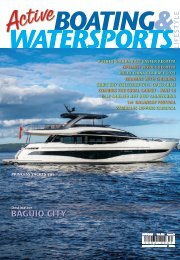ABW Dec 2017
Create successful ePaper yourself
Turn your PDF publications into a flip-book with our unique Google optimized e-Paper software.
y concerned teachers and parents, the wisdom<br />
of environmental protection and conservation.<br />
Every time a species becomes extinct owing to<br />
man’s greed or negligence, mankind is poorer,<br />
for the gene pool is diminished, as consequently<br />
are the resources available to it in terms of<br />
potential economic, survival or aesthetic value.<br />
This pilot Butterfly Sanctuary has provided in its<br />
modest space the natural habitat of 55 butterfly<br />
species and scores of moths and associated fauna.<br />
Itself a veritable botanical<br />
garden, it has grown within<br />
the 1,460-square-meter<br />
enclosure more than one<br />
hundred plant species,<br />
some serving as part of<br />
the life-support system of<br />
butterflies in their larval<br />
stages. Although many<br />
a visitor strays into the<br />
garden to catch a glimpse<br />
of these flying gems in their<br />
poetry in motion, through the years students<br />
with scientific inclination have been assisted in<br />
their term papers and master’s theses by having<br />
materials in the Sanctuary available for them<br />
for research on natural history. It is also a place<br />
where sometimes an overenthusiastic adult,<br />
with sharpened reflexes, can be young again by<br />
chasing something beautiful and elusive.<br />
Casa Gorordo Museum Cebu<br />
The Casa Gorordo Museum, located in Lopez<br />
Jaena Street, is one of the best preserved<br />
Spanish colonial houses in Cebu.<br />
Once home to the first Filipino<br />
Bishop of Cebu, it was<br />
Casa Gorordo was<br />
declared a historical<br />
landmark of the nation<br />
in 1991, by the National<br />
Historical Institute Board.<br />
acquired by the Spanish merchant Juan Isidro<br />
De Gorordo in 1863 and four generations of his<br />
family lived there. Built of timber and stone it<br />
typifies Spanish architecture in the Philippines<br />
and is situated in the Parian district, once home<br />
to Cebu’s most prominent families.<br />
Within the museum are religious relics, antique<br />
furniture, paintings and household items that<br />
reflect the lifestyle of the period, including<br />
ceramics and pottery. The courtyard is quite<br />
pretty and the museum well<br />
maintained and carefully<br />
refurbished to maintain<br />
the integrity of the original<br />
house. Built by Alejandro<br />
Reynes Y. Rosales in the<br />
middle of the 19th Century,<br />
the building was acquired<br />
by the Ramon Aboitiz<br />
Foundation, Inc., in 1980.<br />
After restoration,the home<br />
was turned into a museum<br />
and opened to the people. Casa Gorordo was<br />
declared an historical landmark of the nation in<br />
1991, by the National Historical Institute Board.<br />
Fort San Pedro<br />
Fort San Pedro is the oldest, and smallest,<br />
triangular bastion fort in Cebu, was named<br />
after the galleon ‘San Pedro’ on which Miguel<br />
Lopez De Legaspi, navigator and governor who<br />
founded Cebu in 1565, sailed the Pacific. Two<br />
sides of the fort face the sea and were equipped<br />
with cannon to ward off unwelcome visitors.<br />
Entrance to the fort is on the third side which is<br />
the base of the triangle and looks inland towards<br />
the city. Fort San Pedro was briefly the focus<br />
Casa Gorordo Museum<br />
53


















